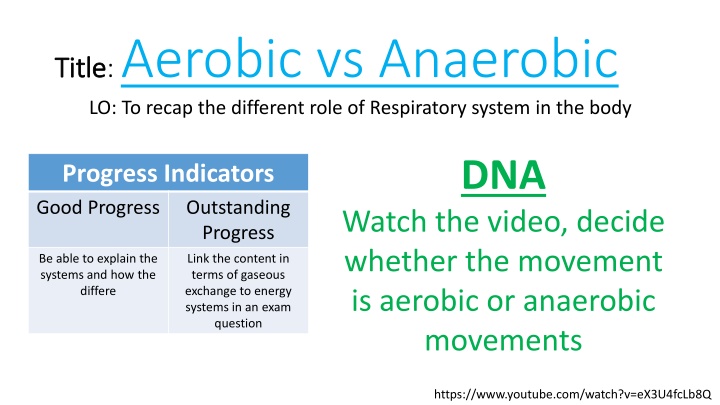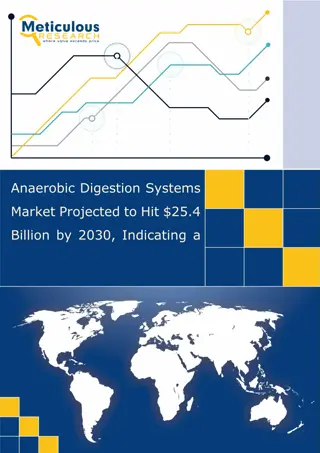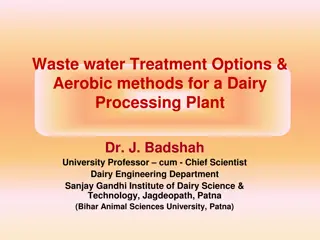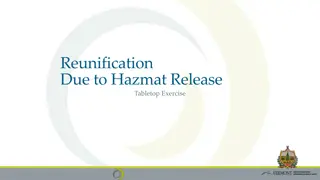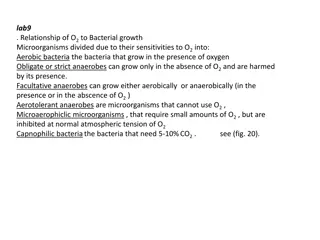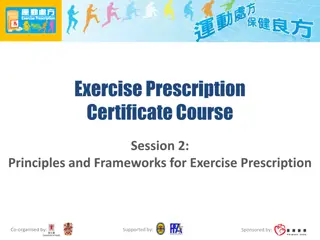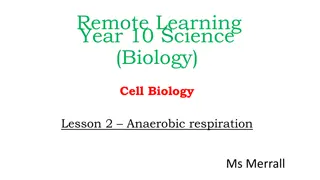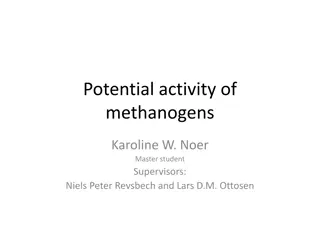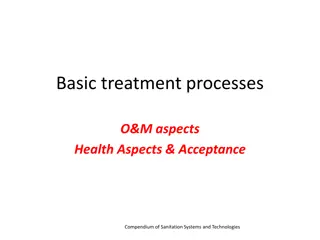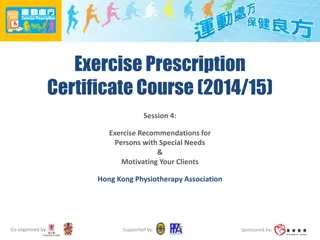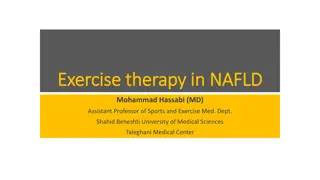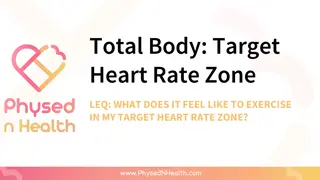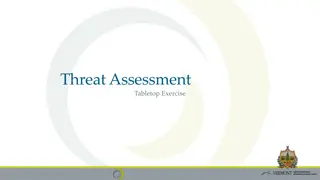Aerobic and Anaerobic Exercise Systems
The content discusses the differences between aerobic and anaerobic exercise, detailing how each system utilizes oxygen or stored energy for energy production. It explores the role of gaseous exchange in energy systems and relates it to the respiratory system's function. Additionally, it covers the importance of oxygen debt and how the cardiovascular and respiratory systems collaborate to support physical activities.
Download Presentation

Please find below an Image/Link to download the presentation.
The content on the website is provided AS IS for your information and personal use only. It may not be sold, licensed, or shared on other websites without obtaining consent from the author.If you encounter any issues during the download, it is possible that the publisher has removed the file from their server.
You are allowed to download the files provided on this website for personal or commercial use, subject to the condition that they are used lawfully. All files are the property of their respective owners.
The content on the website is provided AS IS for your information and personal use only. It may not be sold, licensed, or shared on other websites without obtaining consent from the author.
E N D
Presentation Transcript
Title: Aerobic vs Anaerobic LO: To recap the different role of Respiratory system in the body Title DNA Progress Indicators Good Progress Outstanding Progress Watch the video, decide whether the movement is aerobic or anaerobic movements Be able to explain the systems and how the differe Link the content in terms of gaseous exchange to energy systems in an exam question https://www.youtube.com/watch?v=eX3U4fcLb8Q
Aerobic exercise Aerobic exercise need a sufficient supply of oxygen to the tissues. Anaerobic exercise No oxygen is used in its initial release, energy is produced from the supplies already in the body. Maximum bursts of energy Time it takes to do is very short Extension task Explain how a games player would use both aerobic and anaerobic systems (4 marks) Work for a long time Moderate hard work Periods of more then 60s Glucose Glucose + Oxygen Energy + Lactic acid CO2 + water + Energy
Aerobic exercise Aerobic exercise need a sufficient supply of oxygen to the tissues. Anaerobic exercise No oxygen is used in its initial release, energy is produced from the supplies already in the body. Maximum bursts of energy Time it takes to do is very short Extension task Explain how a games player would use both aerobic and anaerobic systems (4 marks) Work for a long time Moderate hard work Periods of more then 60s Glucose Glucose + Oxygen Energy + Lactic acid CO2 + water + Energy
Energy Energy The muscles and liver store glucose (main source of energy from food) Aerobic Respiration - Glucose + oxygen -----Energy + CO2 + water Is toxic!, causes muscle ache, cramps eventually stopping them from working! Anaerobic Respiration - Glucose -----Energy + lactic acid The muscles and liver store glucose (main source of energy from food) Fats: Carbohydrates: Fuel source for anaerobic and aerobic activity Fuel source for aerobic activity
Oxygen debt Oxygen debt Oxygen debt is . Oxygen debt is The amount of oxygen needed at the end of a physical activity to break down lactic acid. Often after a 400m race lactic acid builds up as the oxygen stores have run out. Oxygen is repaid through deep gasping breaths at the end of exercise. Anaerobic Respiration - Glucose -----Energy + lactic acid
Explain how the Cardiovascular system and the respiratory system work together (6)? Explain how the Cardiovascular system and the respiratory system work together (6)? define State knowledge and understanding of a topic describe Identify Explain how Explain why Apply knowledge and understanding Give examples to back up your point assess discuss Justify why Analyse and evaluate analyse evaluate
Oxygen debt (take on enough oxygen until it is paid off) Muscle fatigue (because of the build up of lactic acid) Lactic acid build up (during anaerobic exercise) known as lactate accumulation Increased breathing rate Respiratory Increase cardiac output Muscular Cardiovascular Increased tidal volume Oxygen debt as a result of anaerobic exercise Increase heart rate Increase in blood pressure (diastolic & systolic) Increase in stroke volume
Long term effects Long term effects Respiratory Cardiovascular Muscular-Skeletal Increased lung capacity / volume Increased vital capacity Diaphragm and intercostal muscles get stronger Number of alveoli increases Increase strength Increase size (hypertrophy) Increase bone density Increased strength of ligaments Increase strength of tendons More capillaries in the muscles Increased cardiac output Increased Stroke volume Decreased resting HR Faster recovery Healthy Veins and arteries Lower blood pressure More red blood cells All means you have a quicker recovery rate
Task Task Functions of the cardiovascular system Make any form of revision tool in your homework book on the content on the left (all 4 bullet points) Muscle fibres Structures of arteries, capillaries and veins Give a sporting example of the anaerobic system & aerobic system working together (explain how) If you do what you ve always done you get what you ve always got!
